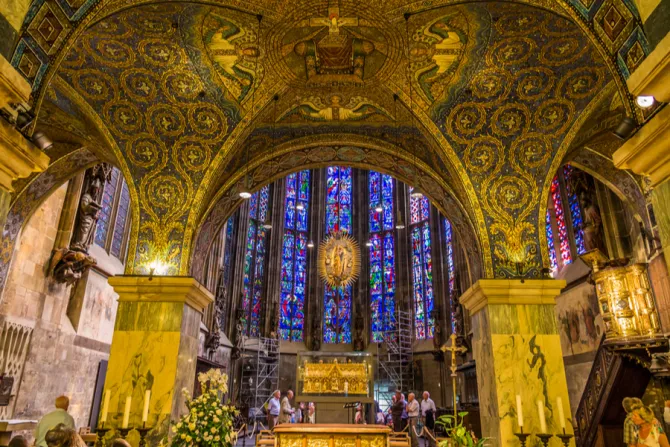CNA Staff, Mar 27, 2020 / 07:30 am
A German cathedral will publicly display the relics of St. Corona, an early Christian martyr, once the COVID-19 outbreak has ended in the country.
The Catholic cathedral in the city of Aachen, western Germany, was already planning to display the reliquary of St. Corona before the global COVID-19--also known as the novel coronavirus--pandemic struck. The shrine was to be included in an exhibit on goldwork and gold craftsmanship, and has not been able to be viewed by the public for the past 25 years.
The cathedral, commonly known as the Imperial Cathedral because it was used by the Emperor Charlemagne, has housed the relics since the year 997 AD.
A spokeswoman for the cathedral was quoted by Reuters saying that, due to the coincidence of the saint's name and the subfamily of the virus that has infected thousands of people around the world, she expects there to be "more interest" in viewing the saint's remains.
"We have brought the shrine out a bit earlier than planned," said the spokeswoman, Daniela Loevenich.
It is not yet known when the public will be able visit and venerate the relics St. Corona - Germany has banned gatherings of more than two unrelated people in an attempt to stem the spread of COVID-19, which has killed nearly 200 people in the country.
The saint's name, Corona, comes from the Latin word for "crown." She is also known as St. Stephanie, derived from the Greek word stephanos, which also means "crown." The subfamily of viruses known as "coronaviruses" were named for their resemblance to crowns.
St. Corona is believed to have been martyred as a 16-year old in the second century, but few details are known about her. Tradition holds that her martyrdom occurred after she, hearing that St. Vincent was being tortured for his Christian faith, confessed her own faith and was subsequently executed.
The two saints share a feast day of May 14.
Despite viral internet posts stating that St. Corona is the patron saint of epidemics, she is actually venerated as the patroness of treasure hunters and lumberjacks, the latter because of the tradition that she was martyred by being tied between two palm trees.
St. Edmund and St. Roch are venerated as the patron saints of pandemics and the plague.
St. Edmund was credited for saving the city of Toulouse from the plague in the early 17th century, and St. Roch was invoked many times in the centuries after his death for protection from plagues and other ailments.


